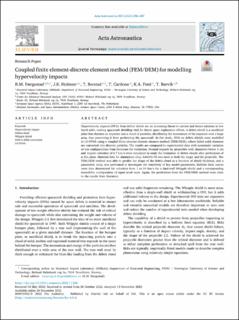| dc.contributor.author | Færgestad, Rannveig Marie | |
| dc.contributor.author | Holmen, Jens Kristian | |
| dc.contributor.author | Berstad, Torodd | |
| dc.contributor.author | Cardone, Tiziana | |
| dc.contributor.author | Ford, Kevin Anthony | |
| dc.contributor.author | Børvik, Tore | |
| dc.date.accessioned | 2023-03-13T09:31:21Z | |
| dc.date.available | 2023-03-13T09:31:21Z | |
| dc.date.created | 2022-12-08T12:55:24Z | |
| dc.date.issued | 2022 | |
| dc.identifier.issn | 0094-5765 | |
| dc.identifier.uri | https://hdl.handle.net/11250/3057875 | |
| dc.description.abstract | Hypervelocity impacts (HVIs) from orbital debris are an increasing threat to current and future missions in low Earth orbit, making spacecraft shielding vital for future space exploration efforts. A debris shield is a sacrificial plate that shatters an impactor into a cloud of particles, distributing the momentum of the impactor over a large area, thus preventing it from perforating the spacecraft. In this study, HVIs on debris shields were modelled in LS-DYNA using a coupled finite element-discrete element method (FEM/DEM), where failed solid elements are converted into discrete particles. The results are compared to experimental data with systematic variation of test configurations from literature for validation. Normal impacts by projectiles with diameters below 1 cm and impact velocities of 6.7 km/s were simulated to study the formation of debris clouds after perforation of a thin plate. Material data for aluminium alloy AA6061-T6 was used in both the target and the projectile. The FEM/DEM method was able to predict the shape of the debris cloud as a function of shield thickness, and a parametric study was performed to investigate the sensitivity of key model parameters. Ballistic limit curves were then determined for velocities from 1 to 14 km/s for a dual-wall Whipple shield and a corresponding monolithic configuration of equal areal mass. Again, the predictions from the FEM/DEM method were close to the results from literature. | en_US |
| dc.language.iso | eng | en_US |
| dc.publisher | Elsevier | en_US |
| dc.rights | Navngivelse 4.0 Internasjonal | * |
| dc.rights.uri | http://creativecommons.org/licenses/by/4.0/deed.no | * |
| dc.title | Coupled finite element-discrete element method (FEM/DEM) for modelling hypervelocity impacts | en_US |
| dc.title.alternative | Coupled finite element-discrete element method (FEM/DEM) for modelling hypervelocity impacts | en_US |
| dc.type | Peer reviewed | en_US |
| dc.type | Journal article | en_US |
| dc.description.version | publishedVersion | en_US |
| dc.source.journal | Acta Astronautica | en_US |
| dc.identifier.doi | 10.1016/j.actaastro.2022.11.026 | |
| dc.identifier.cristin | 2090632 | |
| cristin.ispublished | true | |
| cristin.fulltext | original | |
| cristin.qualitycode | 1 | |

